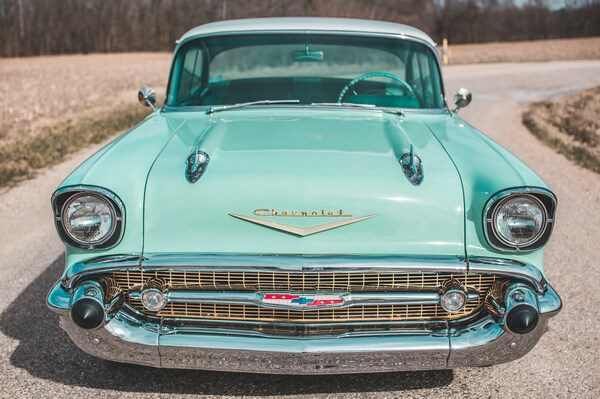Vintage car photography is one of the most exciting and rewarding types of photography. There’s something about capturing the beauty of a classic car that feels timeless.
In this guide you all get the tips you need to take your vintage car photos to the next level. What makes vintage cars perfect photography subjects to mastering the best equipment and techniques. I’ll walk you through everything you need to know.
Vintage cars are beautiful, and they have an undeniable charm that modern vehicles can’t match. The fine details, the history, and the craftsmanship of these cars make them irresistible to photograph.
In this guide, I’ll show you how to capture the essence and history of classic cars. Also you will learn how to make them look their absolute best through the lens of your camera.
Top Race Car Photography Tips for Thrilling Shots
Understanding Vintage Car Photography
What is Vintage Car Photography?
Vintage car photography is all about capturing the classic beauty of old cars. It includes intricate details to their sweeping curves.
It’s a form of automotive photography that focuses on showing the essence and nostalgia of cars that are no longer in production. These cars often have a certain character that modern cars simply can’t replicate.
It makes them perfect subjects for photography. The goal is to freeze their timeless appeal in a way that speaks to the viewer.
One thing that sets vintage car photography apart from photographing modern vehicles is the unique challenge it presents. The design and aesthetics of vintage cars are vastly different from today’s models.
They often feature bold lines, curves, and finishes that reflect a bygone era. In vintage car photography, the focus is on capturing these unique characteristics in a way that highlights their beauty and history.
Want your vintage car photographs edited by professionals? Contact Us!
Why Vintage Cars Make Perfect Photography Subjects
Vintage cars are perfect subjects because of their rich history and craftsmanship. Each one has its own story, and capturing these stories through photos is what makes the process so special.
The intricate details like chrome bumpers, leather interiors, and unique curves, offer a lot of visual interest. These cars are pieces of art in themselves. Your job as a photographer is to show them off in the best possible way.
There’s also an emotional aspect to photographing vintage cars. They evoke a sense of nostalgia and connection to the past.
Many people who own these cars have deep personal connections to them. It can be a family heirloom or a car they’ve restored themselves.
The emotional power of vintage cars in photos is undeniable. That’s why apturing that essence can make for a powerful image.
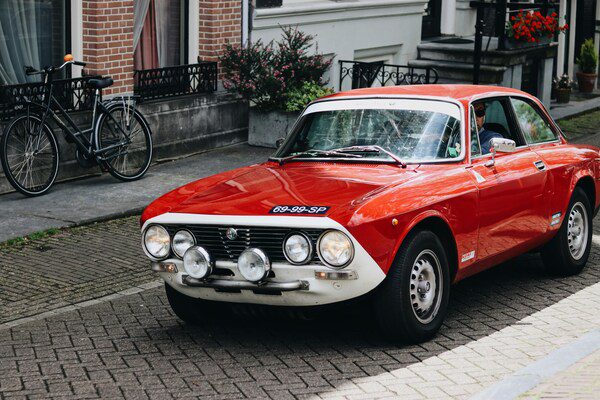
Popular Vintage Cars in Photography
Some vintage cars have become iconic in the sector of photography. Cars like the Ford Mustang, Porsche 911, and Chevrolet Corvette are favorites among photographers and car enthusiasts alike.
These cars not only have timeless designs but also a history that adds to their appeal. You should think about how the model’s design will influence the style of your photography when choosing a car to photograph.
A sleek and low-riding car will offer different angles and compositions than a larger and more boxy one. This can help you decide how to approach the shot and from framing to lighting.
The Ultimate Guide to Car Show Photography Mastery
Essential Equipment for Vintage Car Photography
Camera Gear for Vintage Car Photography
You’ll need the right gear to capture the full beauty of a vintage car. You don’t need to break the bank to get amazing shots, but having the right equipment can make all the difference.
- Camera Type:
DSLR cameras and mirrorless cameras are both excellent choices for vintage car photography. They offer great image quality and the flexibility to switch lenses. I personally prefer DSLR cameras because of their ease of use and versatility.
But mirrorless cameras are lighter and can offer similar results. If you’re feeling nostalgic then film cameras can also give your photos a vintage feel that complements the subject.
- Lenses:
Wide-angle lenses are fantastic for capturing the full body of a vintage car. They help you to fit the entire car into the frame without distortion. A prime lens can also be great for focusing on specific details such as the chrome trim or the interior.
I recommend using a lens with a focal length between 24mm and 50mm for general shots, and something longer like 85mm for close-ups.
- Essential Accessories:
Tripods, filters, remote shutters, and reflectors are also key to improving your shots. A tripod will help keep your camera steady. This is great in low-light conditions. On the other hand, filters can help control reflections and enhance colors.
Remote shutters are perfect for avoiding camera shakes when taking long exposures. Reflectors are also great for bouncing light onto the car’s body to add depth and definition.
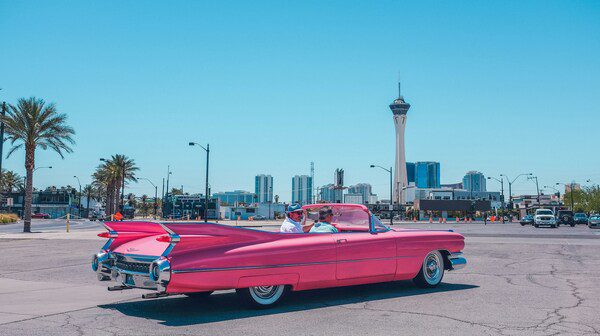
Using Light to Enhance Vintage Car Photos
Lighting is everything when it comes to vintage car photography. The right light can highlight the curves and details of the car. It also makes it look more striking and dynamic.
- Natural vs. Artificial Light:
Natural light works wonders for vintage car photography. Especially during the golden hour (the hour before sunset and after sunrise). The soft and warm light at this time enhances the car’s features and creates a beautiful feel.
If you’re shooting indoors or at night then artificial lighting will be necessary. You should consider using softboxes or diffused lights to avoid harsh shadows that can detract from the car’s features.
- Golden Hour Photography:
The golden hour is one of the best times to shoot vintage cars. The soft and golden light gives the car a warm glow that brings out its details.
If you’re shooting outside then try to plan your shoot around this time for the best results. The lighting is perfect for capturing the car’s curves. Especially when the sunlight hits them just right.
- Controlling Light and Shadows:
Lighting can be tricky when photographing reflective surfaces such as the body of a vintage car. The trick is to control the light and shadow balance.
I recommend using reflectors to fill in shadows and highlight the car’s curves. You can also experiment with backlighting to create dramatic effects. This also makes the car look even more striking.
Specialized Gear for Classic Car Photography
For those who want to take their vintage car photography to the next level, here are some specialized tools that can help:
- Lens Filters:
Lens filters are great for enhancing the reflections on a car’s body and adding vibrancy to the colors. Circular polarizers are especially useful for reducing glare and making the car’s paint pop.
- Drone Photography:
Drone photography offers unique perspectives that traditional cameras can’t. Capturing a vintage car from above can add a sense of scale and context to your photos. This is really cool if you’re shooting a car on an open road or in a scenic location.
- Lighting Kits for Studio Shoots:
If you’re photographing vintage cars indoors then a lighting kit is essential. Softboxes, spotlights, and other studio lighting setups can help you control the light and create professional-looking shots. You can also experiment with different lighting styles to give your images a high-end feel.
Vintage car photography is all about celebrating the beauty and history of classic cars. You can create stunning photos that capture their timeless appeal with the right equipment, lighting, and techniques.
If you’re shooting outside during golden hour or setting up a studio shoot then each shot is an opportunity to showcase the craftsmanship and character of these incredible machines.
If you’re ready to dive deeper into vintage car photography and refine your skills then check out these photos on Unsplash for inspiration:
Finding the Perfect Location for Vintage Car Photography
The location you choose can make or break your shot for vintage car photography. The right background can emphasize the beauty of the car. On the other hand, the wrong one can take away from it.
Let’s learn how you can find the perfect spot for your next shoot.
Outdoor Locations for Stunning Shots
For outdoor vintage car photography you can select a scenic background that complements the car is key. Urban settings such as old streets or industrial areas work well to highlight the car’s sleek lines and vintage charm.
If you’re shooting in a natural landscape then think about how the environment can enhance the story of the car. Imagine a classic Ford Mustang parked near a retro diner or a Porsche 911 on a winding country road. It’s these kinds of shots that capture the essence of both the car and its surroundings.
Urban settings can offer a modern yet nostalgic vibe. Because natural landscapes can evoke a sense of timelessness. Both approaches have their own appeal. This depends on the mood you’re going for in your classic car photography.
Some popular spots for vintage car outdoor shoots include classic city streets, open roads, and industrial areas. These settings provide a dynamic contrast to the vintage style of the car. If you want more inspiration, check out this video on the best outdoor locations for car photography:
The Importance of Lighting in Different Locations
Outdoor lighting plays a huge role in how your vintage car photos turn out. The golden hour is the perfect time for those glowing shots that make vintage cars look their best. The lighting adds depth and highlights the car’s curves and makes it look even more stunning.
Reflectors and diffusers are essential when shooting outdoors. They help soften harsh shadows and bring out the details in the car’s design.
If you’re shooting in different weather conditions such as fog or rain, don’t worry! These conditions can actually add a unique atmosphere to your photos. Fog creates a soft and mysterious look. And rain can add drama with reflections.
Studio Locations for Controlled Vintage Car Photography
Setting up your own vintage car studio is a great idea for more controlled shots. Indoor car photography helps you to control everything including lighting, angles, even the backdrop. You can create a space that highlights the car’s best features without worrying about the outside elements.
A simple backdrop, some props, and proper lighting can make a huge difference in how your vintage car looks in a studio setting. Make sure to have lights that can emphasize the details of the car. A classic car studio setup will help you to take photos that focus purely on the car without distractions from the environment.
Composition Techniques for Stunning Vintage Car Photos
Once you’ve picked the right location, it’s time to focus on composition. Proper framing and angles can elevate your vintage car photography and make your images stand out.
Framing and Angles: Finding the Best Perspective
The angle you choose can tell a different story when shooting a vintage car. Side profile shots highlight the car’s design and symmetry. Top-down shots work great for showing off the roof and intricate details. 3/4 angle shots are fantastic because they offer a dynamic view of the car from the front and side.
If you want to capture both the full beauty and intricate details of the car then try mixing close-ups and wide shots. The vintage car composition really shines when you focus on symmetry and lines. Think about how the curves of the car contrast with the surrounding environment.
The Rule of Thirds and Leading Lines
The Rule of Thirds is an essential photography principle and it works great in classic car photography. Imagine placing the car in one third of the frame, leaving the rest open. It creates a balanced image that’s visually pleasing.
Leading lines, like roads, fences, or rail tracks can also draw the viewer’s eye directly toward the car. These lines help guide attention and emphasize the car’s design.
Incorporating Movement into Car Photography
If you want to bring your vintage car photography to life then try adding some motion. Capturing the movement of a vintage car in action can add energy to your shots.
Practice panning the camera as the car moves to get that perfect shot. It takes some patience but the results are always worth it.
7 Best Car Image Editing Services for Eye-Catching Listings
Styling and Preparing the Car for Photography
A little prep goes a long way in ensuring your vintage car photos turn out perfect. If you’re working with a restored classic or a car with some wear and tear then there are a few things you can do to make it shine.
Cleaning and Detailing the Vintage Car
Take the time to clean the car before you start shooting. A spotless car always looks better on camera, and it’s easier to photograph without distractions like dirt or smudges.
Focus on the chrome, tires, and paintwork. Because these details are essential to creating that polished, timeless look. It’s also important to preserve the car’s authenticity. The wear and tear tell a story. So avoid over-polishing or hiding imperfections.
Customizing the Car’s Look for the Shoot
If you want to give the car a unique look then choose the right props and accessories. Vintage license plates, period-correct items, or even a retro scarf on the rearview mirror can add character to your photos.
Make sure that whatever you choose matches the car’s personality and enhances the overall feel. The key is to create a harmonious look between the car and its surroundings.
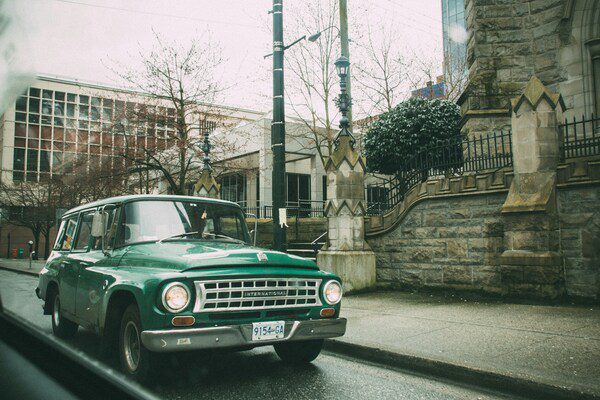
Dealing with Imperfections in Classic Cars
Vintage cars have their share of imperfections. Rust, dents, and scratches are all part of their charm. Don’t try to hide them! Instead, use photography to highlight these details.
A classic car’s aesthetics are often defined by the wear it’s collected over the years. Post-processing can help either enhance or minimize imperfections, but don’t overdo it. Let the car’s character shine through.
By following these steps, you’ll be able to create stunning, timeless vintage car photos that not only capture the essence of the vehicle but also tell a story that resonates with viewers. Whether you’re shooting outdoors, in the studio, or focusing on the smallest details, every step counts in making your photos as beautiful as the cars themselves.
How to Edit Car Photos on iPhone Like a Pro! (5 Easy Steps)
Post-Processing Tips for Vintage Car Photography
Once you’ve captured those stunning vintage car photos, the next step is editing. Post-production is where the magic happens. You can enhance your photos and make them truly shine with the right techniques.
Editing Vintage Car Photos in Post-Production
In the editing phase, the first thing I focus on is getting the exposure, contrast, and sharpness right. It’s important to make sure the car’s features pop without overdoing it.
A little tweak in contrast can help highlight the curves of the car. Ensure that you capture the right amount of light and shadow while adjusting exposure.
For a nostalgic vibe, I often add warmth or sepia tones, which can really evoke that classic look in vintage car photography. This is a great way to add a timeless feel to your shots, making them feel like they’re straight out of the past.
Don’t forget about highlights and shadows! Adjusting these settings will bring out those fine details in the car, like the shine of chrome or the depth of the tires. It’s all about revealing the car’s personality through light and shadow.
Enhancing Details Without Overdoing It
It’s important to enhance the details of the car without making it look unnatural. I keep the editing light to maintain the car’s authenticity. After all, vintage car photography is about capturing the true beauty of these classics, not over-editing them.
When there are distractions in the background, I’ll often remove them to keep the focus on the car. It can be a cluttered background or random objects that take attention away from the subject. Cleaning up the image also makes the car the star of the shot.
Advanced Editing Techniques for a Timeless Look
I love using color grading or filters to create a vintage look for a more dramatic effect. This helps give the photo an aged feel, as if the car had been photographed decades ago. Adding textures or grain can also help give the image a more authentic, timeless vibe.
Sometimes, black-and-white photography is the perfect choice for classic car photos. Removing color can really highlight the car’s shape and details. This gives it a more dramatic and sophisticated look.
Helpful resources:
- How to Edit Car Photos in Photoshop for Jaw-Dropping Results (5 Steps)
- How to edit car photos in Lightroom mobile (6 Easy Steps)
The Art of Storytelling Through Vintage Car Photography
A great vintage car photo isn’t just a picture of a car—it’s a story. Let’s talk about how you can tell the car’s story through your lens.
Capturing the Essence of a Vintage Car’s History
Every vintage car has a story to tell. Whether it’s a classic Mustang or a vintage Rolls Royce, capturing the essence of the car’s history is key. I like to think about the car’s past—where it’s been, the people who’ve owned it, and what makes it unique. You can convey this by focusing on small details, like worn leather seats or faded paint.
Storytelling in photography is all about creating a mood. Is the car part of a love story? A road trip adventure? Or maybe a racing legend? Creating this emotion in your shots is what will make them stand out. Adding shadows, playing with light, or choosing a specific location that fits the car’s narrative will help tell that story visually.
Creating a Narrative in a Photo Series
One powerful way to tell a vintage car’s story is through a photo series. Instead of taking one shot, shoot multiple images that tell a complete story. Maybe you start with the car parked in a scenic spot, then show it driving on the open road, and finish with a close-up of the car’s details.
You can create themes for your photo series, like restoration, road trips, or vintage car rallies. This gives your photos context and turns them into a story that viewers can follow and connect with.
Incorporating People in Vintage Car Photography
Sometimes, adding people to your shots can really bring the car to life. The connection between people and cars is often deep and emotional, especially with vintage models. Whether it’s a model in period-accurate clothing or the car’s owner, having someone in the photo can add a personal touch to your vintage car photography.
Styling models for a shoot is crucial. You want the look to match the era of the car—think about vintage clothes or accessories that fit the time period. By doing this, you’ll create a more immersive, period-accurate shot that tells a compelling story.
Advanced Vintage Car Photography Tips
Now that you’ve mastered the basics of vintage car photography, let’s talk about some advanced techniques to really make your photos stand out.
Using Reflection and Glass for Creative Shots
Reflections are one of my favorite tools in car photography. The car’s bodywork, windows, or even puddles on the ground can create stunning reflections that add depth and creativity to your shots. Try shooting vintage cars in mirrors or puddles—this adds an artistic touch and a layer of complexity to the image. If you’re interested in learning more, check out this guide on reflective car photography.
Shooting at Night: Capturing Cars Under the Stars
Nighttime photography can be magical, especially when it comes to vintage car photography. Shooting a car under the stars or in low light conditions can give it an entirely new feel. To get the perfect shot, you’ll need to balance artificial light with ambient light from the surroundings. This creates a dramatic effect that highlights the car while still capturing the beauty of the night.
Exploring Motion and Dynamic Shots
If you want to add some energy to your vintage car photography, try shooting cars in motion. Capturing a car speeding down a road, or even with blurred backgrounds, gives your images a sense of movement and excitement. Techniques like light trails, motion panning, or even capturing a car’s wheels in motion can make your photos look dynamic and full of life.
By following these tips and techniques, you can take your vintage car photography to the next level. Whether you’re focusing on post-processing, telling a story, or experimenting with advanced techniques, there’s always something new to learn. So get out there, shoot those beautiful classic cars, and let your creativity shine!
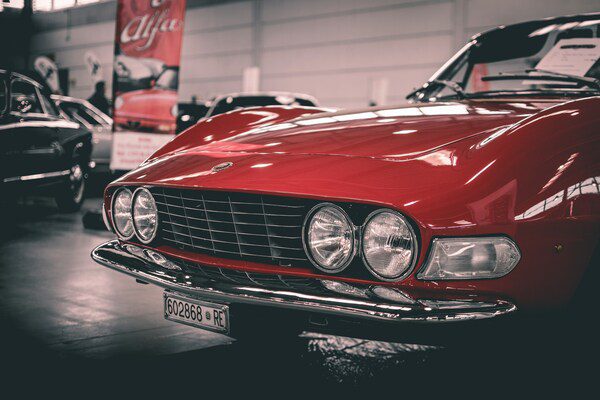
Showcasing and Sharing Your Vintage Car Photography
Printing and Displaying Your Vintage Car Photos
Once you’ve captured some stunning vintage car shots, printing them can take your work to the next level. For personal use, high-quality prints on matte or glossy paper can make your photos stand out. Consider creating photo albums or wall art featuring your best vintage car photography to display at home or in your studio.
If you work with clients, offer professional options like canvas prints, metal prints, or custom photo books. These are great ways to preserve and showcase vintage car photos in a tangible format. You might even create themed calendars with your photos—perfect for car enthusiasts.
Social Media and Online Sharing
Social media is a great platform for sharing your vintage car photography. Platforms like Instagram and Pinterest are great for visually showcasing your work.
Use hashtags like #VintageCarPhotography, #ClassicCarPhotos, and #RetroCarShots to increase visibility. This strategy can help you reach vintage car fans and potential clients who share your passion.
Make sure to include a brief story about the car or the inspiration behind the shot. This adds a personal touch that viewers appreciate. If you’re on Instagram then try experimenting with Reels or Stories to keep your audience engaged.
For more tips on sharing photography on social media, check out this guide on Instagram tips for photographers.
Building a Portfolio of Vintage Car Photography
Creating a professional portfolio is key if you want to attract clients or collaborators. Showcase your best vintage car shots in a dedicated online gallery. Websites like SmugMug or Squarespace make it easy to set up a sleek portfolio.
Be sure to organize your photos into categories. Such as black-and-white classics, motion shots, or detailed close-ups. A well-structured portfolio helps visitors quickly find what they’re looking for.
Your portfolio can also serve as a calling card for networking at vintage car shows or online forums. For additional advice, check out this article on creating a photography portfolio.
Conclusion
Vintage car photography is an incredible way to combine your love for cars and photography. From choosing the right lighting to adding artistic touches in post-production, every step is an opportunity to showcase the timeless beauty of classic cars.
Remember, there’s no right or wrong way to approach this art form. Experiment, play with different styles, and discover what works best for you. The joy of capturing vintage cars lies in telling their stories through your unique perspective.
I’d love to see your vintage car photos! Feel free to share them or reach out if you have questions or want personalized tips. Let’s keep the love for vintage car photography alive.


